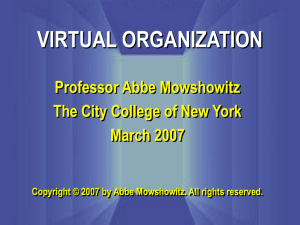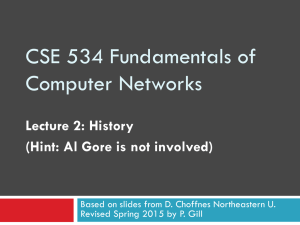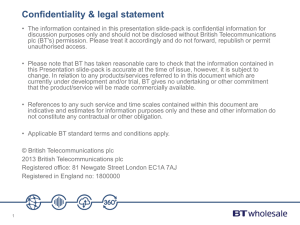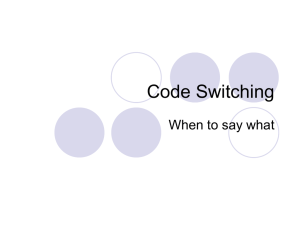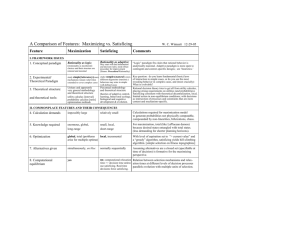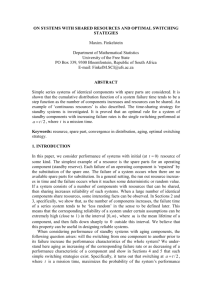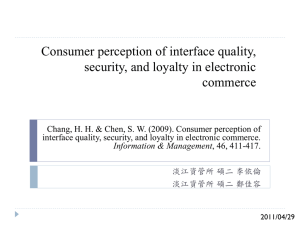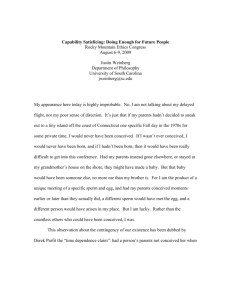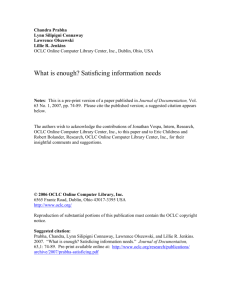5-Virtual Organization
advertisement
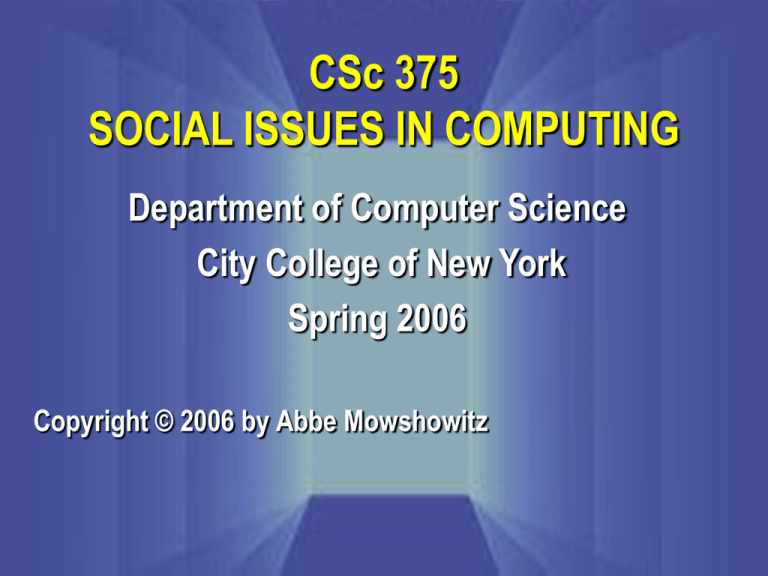
CSc 375 SOCIAL ISSUES IN COMPUTING Department of Computer Science City College of New York Spring 2006 Copyright © 2006 by Abbe Mowshowitz TOPIC 5. VIRTUAL ORGANIZATION A. Introduction 1. Examples a. Company shipping department b. University department 2. Advantages 3. Management challenges 4. Technological substrate TOPIC 5. VIRTUAL ORGANIZATION A.1.a. Shipping Department Services • overnight • three days • one week • two weeks + same day - two weeks Service Providers • postal service • inhouse courier • UPS • FEDEX + DHL - inhouse courier TOPIC 5. VIRTUAL ORGANIZATION WAYS AND MEANS OF DELIVERY overnight postal service three day in house courier one week UPS two weeks FEDEX TOPIC 5. VIRTUAL ORGANIZATION A.1.b. UNIVERSITY DEPARTMENT Services • Intro (C++) • Discrete Math • Data Structures • Software Design + Intro (JAVA) - Intro (C++) Service Providers • Regular Staff • Adjuncts + Adjuncts a,b,c - Regular staff x TOPIC 5. VIRTUAL ORGANIZATION Courses and Staff introduction regular staff discrete math data structures software design adjuncts TOPIC 5. VIRTUAL ORGANIZATION A.2. Advantages? • Leveraged use of resources • Cost savings (e.g., lower overhead) • Greater flexibility TOPIC 5. VIRTUAL ORGANIZATION A.3. Management challenges • Grasping the Potentialities of Virtualizing Commercial Relations • Planning for Change Key: Virtual Organization TOPIC 5. VIRTUAL ORGANIZATION A.4. Technological substrate Transport Computing Telecommunications GLOBAL NETWORKING INFRASTRUCTURE TOPIC 5. VIRTUAL ORGANIZATION B. Faces of Virtuality 1. Examples • Virtual Corporation or Enterprise • Virtual Office • Virtual Team • Virtual Classroom TOPIC 5. VIRTUAL ORGANIZATION B.2. Features • Organizations without walls • Effective use of computer communications • Alliances and joint ventures • Facilities moved at will over space • Distributed organization of work ABSENCE OF WALLS TOPIC 5. VIRTUAL ORGANIZATION C. Unifying Definition 1. Search for common thread among features 2. Related constructs - Virtual Memory (computers) - Virtual Circuit (networks) - Virtual Reality (multimedia) TOPIC 5. VIRTUAL ORGANIZATION C.3. Common to all SPLIT BETWEEN NEEDS AND MODES OF SATISFACTION motivating the following three-part definition TOPIC 5. VIRTUAL ORGANIZATION C.4. Definition (Part 1.) A virtual organization is a goaloriented social unit operating under metamanagement. TOPIC 5. VIRTUAL ORGANIZATION C.4. Definition (Part 2) Metamanagement is the management of a virtually organized task. • Analyzing abstract requirements • Determining concrete satisfiers • Tracking allocations • Maintaining/revising allocation procedure • Reviewing satisficing criteria TOPIC 5. VIRTUAL ORGANIZATION C.4. Definition (Part 3) A virtually organized task consists of (1) abstract requirements (2) concrete satisfiers (3) (re)allocation procedure (switch) (4) ‘satisficing’ criteria TOPIC 5. VIRTUAL ORGANIZATION C.5. Switch THE SWITCH ASSIGNS SATISFIERS TO REQUIREMENTS ACCORDING TO THE SATISFICING CRITERIA TOPIC 5. VIRTUAL ORGANIZATION C.6. Switching complements existing practices a. Division of labor/specialization of function – task simplification – combinational flexibility EFFICIENCY (Adam Smith) CHEAPER LABOR (Charles Babbage) TOPIC 5. VIRTUAL ORGANIZATION C.7. Critical management elements • Abstract requirements • Concrete satisfiers • Assignment of satisfiers to requirements • Tracking assignments • Switching • Satisficing criteria TOPIC 5. VIRTUAL ORGANIZATION C.8. Limitations of switching • Excessive switching can nullify gains • Advantages limited by analogue of thrashing in virtual memory systems TOPIC 5. VIRTUAL ORGANIZATION D. Innovations reflected in virtual organization 1. Systematic use of switching by management 2. Generalized resource allocation model TOPIC 5. VIRTUAL ORGANIZATION D.2.1. Classical allocation methods - Examples: personnel assignment, static resource allocation - Requirements and satisfiers are fixed: little or no switching is involved TOPIC 5. VIRTUAL ORGANIZATION Classical (static) allocation problem TASKS WORKMEN TOPIC 5. VIRTUAL ORGANIZATION D.3. Dynamic resource allocation • • • • Requirements can vary Satisfiers can vary Procedures can vary Systematic switching is supported TOPIC 5. VIRTUAL ORGANIZATION E. General examples of virtual organization in the real world TOPIC 5. VIRTUAL ORGANIZATION E.1. Automobile Assembly SATISFICING CRITERIA: cost-quality relationship SWITCHING: change suppliers COMPONENTS SUPPLIERS TOPIC 5. VIRTUAL ORGANIZATION E.2. Tax Management SATISFICING CRITERIA: minimize overall taxes SWITCHING: shift obligations between plants TAX OBLIGATIONS OBLIGATION PER PLANT TOPIC 5. VIRTUAL ORGANIZATION E.3. Portfolio Management SATISFICING CRITERIA: maximize risk return SWITCHING: substitute investment INVESTMENT TYPES SPECIFIC INVESTMENTS TOPIC 5. VIRTUAL ORGANIZATION E.4. High Tech Help Desk SATISFICING CRITERIA: maximize satisfactioncost ratio SWITCHING: substitute service provider CLIENT SERVICES SERVICE PROVIDERS TOPIC 5. VIRTUAL ORGANIZATION F. What makes virtual organization work? 1. Information commodities 2. Standardization 3. Financial instruments TOPIC 5. VIRTUAL ORGANIZATION F.1. Information commodities a. Goods or services furnishing information b. Computer-based types: software, databases c. Information marketplace TOPIC 5. VIRTUAL ORGANIZATION F.1.c. Information marketplace (i) Computer-based alternatives to human-borne knowledge (ii) Lower costs (iii) Greater flexibility TOPIC 5. VIRTUAL ORGANIZATION F.2. Standardization a. Technical – access (Wireless Application Protocol) – information exchange (XML based EDI) – interaction (conferencing protocols) PROTOCOLS FOR ELECTRONIC COMMERCE TOPIC 5. VIRTUAL ORGANIZATION F.2.b. High level business protocols INTERCHANGEABILITY OF ORGANIZATIONAL PARTS (‘socionomics’ and ergonomics) TOPIC 5. VIRTUAL ORGANIZATION F.3. Financial Instruments • Exchange – online payments – electronic wallets • Financial management – derivatives – hedging strategies • Tools for building new instruments e.g., securitization TOPIC 5. VIRTUAL ORGANIZATION G. Current Practices • Outsourcing (‘cut & paste’) – products and services – labor • Inventory Management – just in time – quick response • Electronic brokerage – customer order management – logistics management TOPIC 5. VIRTUAL ORGANIZATION Global Outsourcing TOPIC 5. VIRTUAL ORGANIZATION E-Brokerage SATISFICING CRITERIA: meet specs at minimal cost SWITCHING: substitute subset REQUEST TYPES SUBSETS OF VENDORS TOPIC 5. VIRTUAL ORGANIZATION H. Costs of virtual organization • Assignment of new satisfier to requirement – transaction (e.g., accounts and database changes) – legal (i.e., new contracts) – interfaces (e.g., new systems) • Requirements analysis and satisfier scanning TOPIC 5. VIRTUAL ORGANIZATION I. Long-Term Implications 1. Claim: Virtual Organization Will Prove Irresistible to Managers because People Act in What They Perceive to Be Their Best Interests and The Competitive Advantage of Virtual Organization Will Become Apparent TOPIC 5. VIRTUAL ORGANIZATION I.2. Balance Sheet • Advantages – efficiency and effectiveness – responsiveness and flexibility • Disadvantages – costs (intelligence, switching) – human relations (weaker ties) TOPIC 5. VIRTUAL ORGANIZATION I.3. Requirements of Switching • Ease of forming, modifying and terminating relationships (‘coupling and decoupling’) – person to person – person to organization – organization to organization • Mobility TOPIC 5. VIRTUAL ORGANIZATION I.4. Transformation of social relations a. Trust: from static, status-based to dynamic, job function-based b. Loyalty: from subjective, affectbased to objective, common interest-based TOPIC 5. VIRTUAL ORGANIZATION I.4.c. Conditions of interaction (i)Homogeneity (reliability ensured by authority and custom) (ii) Diversity (reliability ensured by standardization) TOPIC 5. VIRTUAL ORGANIZATION I.5. Virtuality Reinforces Fragmentation a.Decline of nation state power b. Devolution of power and authority onto ‘private’ organizations TOPIC 5. VIRTUAL ORGANIZATION I.6. Emerging Political Economy • Power and authority centered in virtual organizations • Political power and authority exercised by private organizations • Economic power based on globally distributed resources VIRTUAL FEUDALISM
